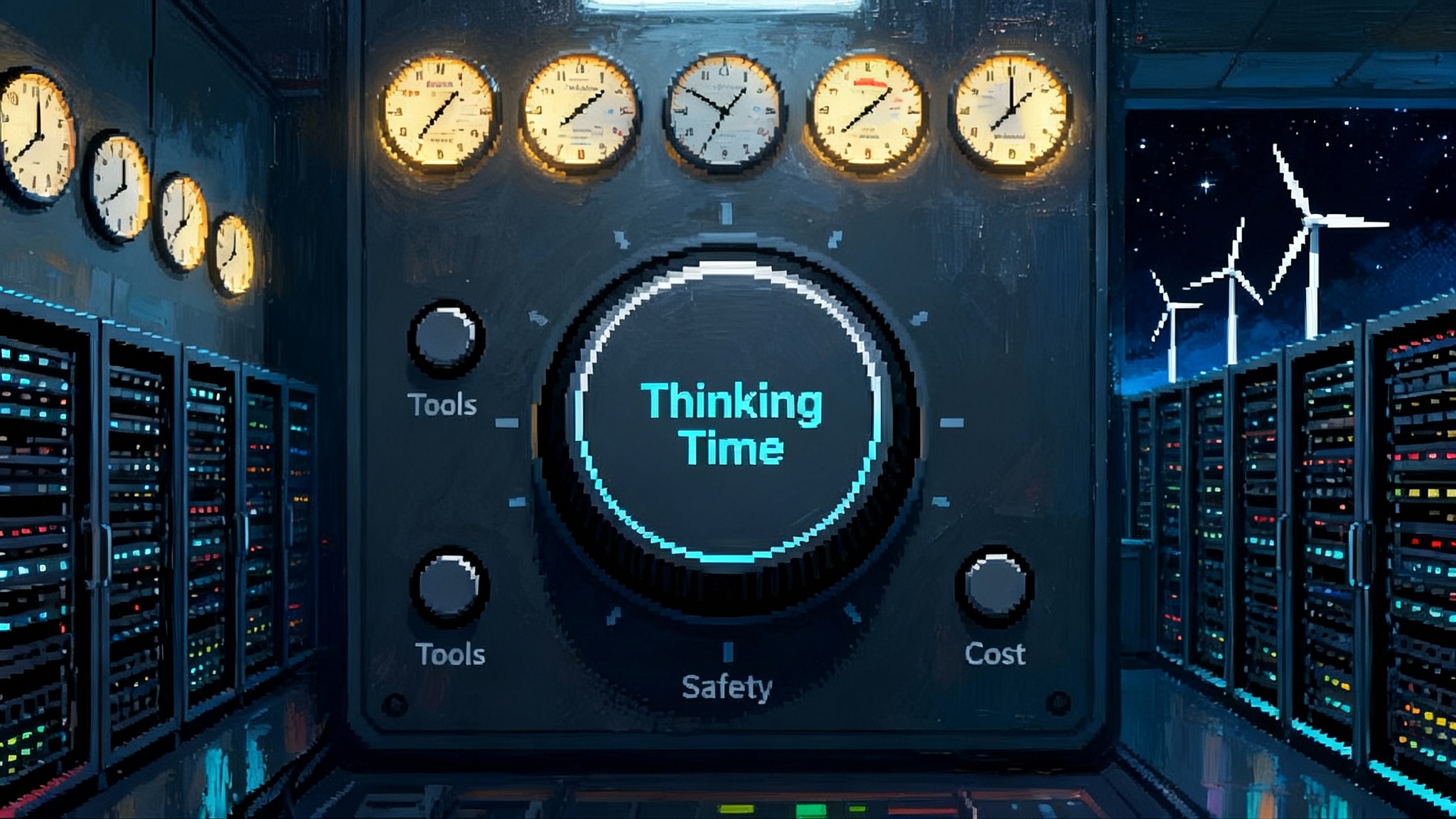The Reasoning Turn: When Compute Becomes a Product Dial
AI is shifting from static model picks to adjustable thinking time. Learn how the reasoning dial reshapes UX, governance, pricing, and geopolitics, and get concrete playbooks to ship dials and receipts with confidence.

The headline everyone missed in 2025
Last year was about who trained the largest model. This year is about who lets you choose how long that model thinks. The demos looked familiar: better math, better code, cleverer multimodal tricks. The quiet breakthrough was different. Reasoning became a user controllable budget.
When OpenAI introduced o3 and o4-mini, the pitch was simple: models that think for longer before answering. Hidden in that release is a pivotal shift. Thinking time is no longer a fixed trait. It is a dial. In consumer products you already see variants with higher or lower reasoning effort. In developer consoles you can request more or less deliberation per task and pay only for what you use.
On the pricing front, DeepSeek grabbed attention by discounting its reasoning model during specific hours. The company advertises off-peak discounts of up to 75 percent between 16:30 and 00:30 Coordinated Universal Time for reasoning workloads, according to Reuters on DeepSeek’s off-peak discounts. That is not a gimmick. It is a market signal: if you can wait until the grid is quiet, you can buy more thinking per dollar.
Put these together and a new architecture of progress appears. Instead of bigger beating smaller, tunable depth beats fixed depth. Intelligence stops being a monolith and starts acting like a budget you allocate.
What it means to make thinking a dial
A camera analogy helps. Exposure time trades speed for detail. Short exposure freezes motion but hides faint stars. Long exposure reveals details but risks blur. For AI, exposure time is the number of internal steps a system spends planning, checking, and revising before it replies.
- Low exposure: autocomplete, formatting, and routine lookups.
- High exposure: theorem proofs, pricing models, complex reconciliations, or safety sensitive decisions.
The dial works because modern reasoning systems can use extra time well. They write intermediate plans, call tools, re-check results, and integrate visual context or external data. Returns are not linear. Some tasks plateau quickly. Others keep improving with more steps and well chosen tools, just like a human analyst who catches mistakes on a second pass.
This rewires how teams build with AI.
- Developers budget latency and dollars across steps instead of picking one model for everything.
- Product managers define service levels in two dimensions: how fast and how right.
- Finance teams forecast cost not just per query, but per unit of reasoning.
UX will change when the model shows its work
User experience is where adjustable thinking becomes visible.
- Speed sliders will sit next to temperature. A support agent might slide from Quick to Careful during a refund exception. A researcher might request two passes: one fast to map the problem, another slow to resolve contradictions.
- Interfaces will preview a plan before committing. Instead of a spinner, you will see an outline, the sources to check, the tests to run, and the exit criteria. If the plan looks wrong, you cancel before the expensive part starts.
- Final answers will carry receipts. High effort responses include a structured trace that lists steps, tools used, and tests performed. If the system claims it validated a contract clause, it shows the snippet it checked and the parse it relied on. For low effort calls, the receipt can shrink to a one line justification.
If you want a deeper dive into why receipts matter, see our take in Receipts Become a Primitive.
Good UX for the dial does three practical things:
-
Default to low effort, then escalate when the system detects ambiguity, safety risk, or high economic stakes. Users should not micromanage compute.
-
Let people pin effort to sub tasks. In a data cleaning pipeline, deduplication can be quick, while schema inference and constraint discovery may deserve longer budgets.
-
Display the marginal value of more thinking. If two extra seconds will add a test or consult a database, say so. If it will likely make no difference, say that too.
Governance gets teeth when deliberation is explicit
When systems reason privately, oversight is guesswork. When they produce interpretable traces, governance becomes engineering. Three concrete changes follow.
- Auditable decisions: A regulator or internal reviewer can inspect each step and replay it. This is stronger than a narrative explanation after the fact. It is a log with timestamps, inputs, outputs, and checks.
- Policy constrained reasoning: You can require specific steps for sensitive domains. A clinical summarizer must include a medication safety check. An underwriting agent must include a bias test and a counterfactual scenario. If the required step is missing, the call fails.
- Bounded risk by design: Set maximum effort for low trust contexts so the model cannot over collect data or overreach in tool use. For high trust contexts, raise the ceiling with human sign off.
To make this real, we will need some standardization.
- A cross vendor trace schema: Think of it as a flight data recorder for model calls. Each step includes tool name, inputs, outputs, the model’s self assessed confidence, and the reason for the step.
- Signed trace segments: Each tool signs its own output so downstream steps cannot alter it silently. If the database returned 17 rows, the trace proves that 17 rows were returned.
- Budget headers: Every request declares its effort budget, safety budget, and tool scope. The response reports what was actually spent. Governance turns into arithmetic.
We argued earlier that signatures are a foundational layer. If you are exploring that stack, cross reference our essay The AI Signature Layer Arrives.
Compute markets will look like power markets
The analogy to electricity is not poetic. It is operational. If AI inference load follows diurnal patterns, off peak pricing is rational. DeepSeek’s discount window hits night in China and the workday in parts of Europe and the United States. That arbitrage invites schedulers, brokers, and new business models.
What to expect in the next four quarters:
- Reasoning spot markets: Cloud providers will publish variable prices for high effort inference. If you can defer a workload by two hours, you will bid for unused capacity. For live chats, you pay a premium to burst when needed.
- Budget aware compilers: Agent frameworks will compile plans that mix on device steps, low effort remote steps, and a few high effort calls where the marginal gain is worth it.
- Market aligned defaults: Consumer products will delay background reasoning until off peak, just as phones defer large downloads to Wi Fi. Your calendar cleaner will run a deep pass at night, not at noon.
This intersects directly with the power crunch many regions face. For context on the energy bottleneck, see our analysis in The Grid Is Gatekeeper.
Winners will wire pricing signals into their planners. A travel concierge that assembles complex itineraries should ask if the user prefers to save money by running the optimizer at 7 p.m. local time or prefers instant results at a higher cost. That is not just courtesy. It can cut inference bills by half without losing quality.
Geopolitics will shift as thinking seeks quiet grids
Once thinking time becomes a commodity, geopolitics follows the load wherever it is cheapest and safest to run.
- Time zones become policy tools: Regions with surplus night power or reliable renewables will market themselves as inference havens. Expect special economic zones that bundle energy, connectivity, and compliance guarantees for high effort workloads.
- Export controls move from chips to time: Governments already control the sale of advanced accelerators. Next they will scrutinize access to large bursts of off peak compute. A hostile actor does not need to smuggle a processor if they can rent a city’s worth of reasoning at 2 a.m.
- Reliability becomes a national asset: Countries with stable grids will attract high effort AI exports the same way they attract aluminum smelters and archival data centers. The reliability premium shows up directly in the price of reasoning.
The case for a small acceleration
There are two ways to accelerate progress. One is to hope safety keeps up while capability rises. The other is to make safety part of how we spend compute.
The pitch is simple.
- Give every serious AI surface an end to end compute dial. Users want outcomes, not model names. Let them trade time, money, and accuracy with sensible defaults and visible marginal gains.
- Require standardized, interpretable traces for high effort calls. These traces do not expose private chain of thought by default. They record steps, tools, constraints, and checks at a level suitable for replay, debugging, and audit.
This duo - dials and receipts - advances capability and accountability at the same time. It also respects competitive secrets. Vendors can redact raw internal thoughts while still producing a verifiable plan and a record of tool use.
Concrete playbooks for teams
Here is how different actors can move now.
Product teams
- Add the effort dial: Expose three presets, for example Quick, Balanced, and Careful. Tie each to latency, spend, and trace verbosity. If you already surface temperature and max tokens, you are halfway there.
- Instrument marginal value: For your top flows, measure the accuracy gain from low to medium to high effort. Publish those deltas in your admin console so operations teams can choose intelligently.
- Escalate by trigger: If the model detects PII, legal risk, or financial impact over a threshold, auto escalate to a higher effort tier and attach a full trace.
Engineers and researchers
- Benchmark by effort, not only by model: Report accuracy, cost, and energy as a function of thinking time. Include plots that reveal where returns plateau and where they keep climbing. For a broader view on why single scores are failing, see The Post Benchmark Era.
- Build planners that price their own steps: Inside an agent, the planner should estimate the value of another tool call or verification pass before doing it.
- Log structured traces by default: Use a schema your compliance team can read. Keep raw internal tokens off by default, but store step graphs and the inputs and outputs of tools.
Policy makers and risk leaders
- Mandate deliberation receipts for regulated domains: Health summaries, financial advice, credit decisions, and safety critical recommendations should carry machine readable traces that can be audited within deadlines.
- Set budget fences: Define allowed effort tiers for certain contexts and caps for tools with irreversible effects. This is easier to enforce than outcome only rules.
- Fund an open trace standard: Convene vendors, clouds, and civil society to agree on a baseline. The first version should be boring, replayable, and signed.
Cloud and compute providers
- Publish reasoning spot prices: Treat high effort inference as a class of service with dynamic pricing and clear service levels.
- Offer trace backed billing: Let customers see which steps consumed tokens and time. That transparency will win enterprise accounts.
- Co locate with clean, steady power: Market low carbon thinking windows. Help customers schedule deep workloads into those windows without manual work.
Enterprises and startups
- Split your workloads: Run low effort passes in the foreground and batch high effort passes overnight. Use alerts to surface conflicting results for human review.
- Keep a flight recorder: For critical workflows, store traces for a defined period. This reduces mean time to resolution and satisfies auditors.
- Negotiate time windows: If you can move high effort compute out of 9 a.m. to 5 p.m., ask your provider for off peak rates. The discount will often cover the engineering work.
What could go wrong and how to make it go right
Adjustable thinking is not free. Bad implementations will overthink easy tasks, run unnecessary tools, and leak sensitive context into traces. The fixes are straightforward.
- Put a price on every step: If a verification pass is expensive, the planner must justify it. If a tool is both costly and risky, require explicit permission.
- Separate private reflections from public traces: Keep raw internal tokens private by default. Make traces about actions and checks, not musings. Redact sensitive data at the edge.
- Sandbox tool use with limits: For long running tasks, restrict the set of allowed tools and cap maximum spend per tool. Escalate to humans when the plan exceeds the envelope.
None of this is exotic. It is a clean application of budgeted planning plus auditability to machine reasoning.
The new pecking order
As more companies ship reasoning first stacks, the leaderboard will be set by three curves rather than one number.
- The effort curve: how quickly accuracy rises as you raise the dial.
- The price curve: how effort converts into dollars at different times and places.
- The trace curve: how useful and verifiable the receipts are to humans and other systems.
Model weight counts will matter less than the ability to spend thought exactly where it pays off.
The close
The most interesting idea in AI this year is not a new brain. It is a new budget. When thinking time becomes a choice, intelligence turns into a market. That market needs dials anyone can use and receipts anyone can check. Build those, and the next wave of progress will not only be smarter. It will be accountable, schedulable, and surprisingly affordable.








